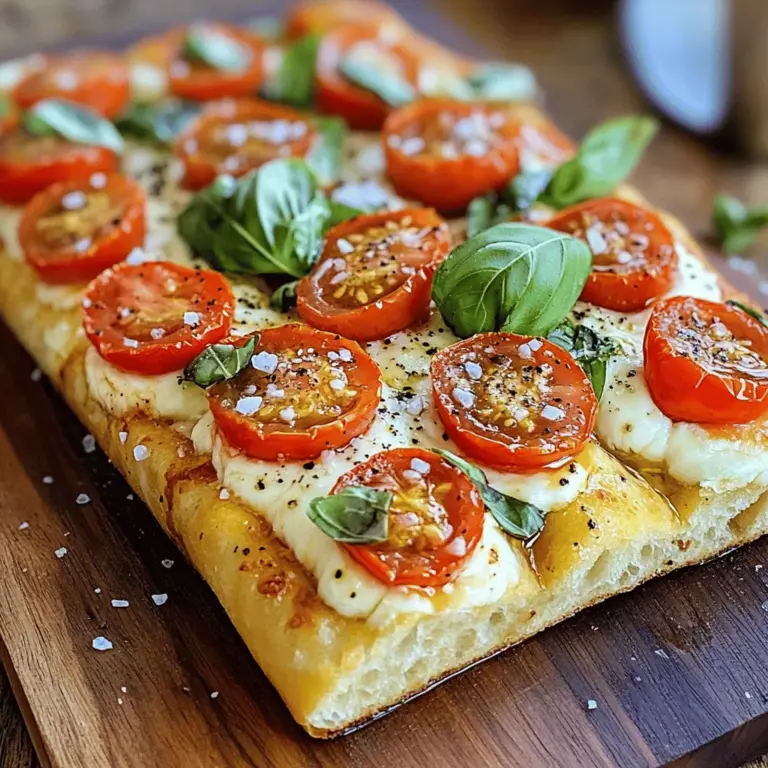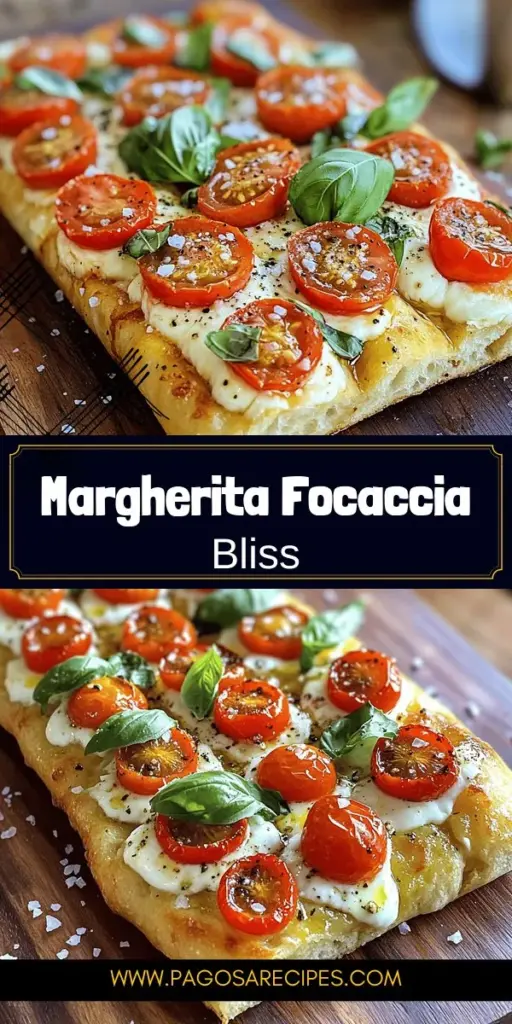Introduction
Margherita Focaccia Bread is a stunning and delectable dish that has captured the hearts of many food enthusiasts around the world. Originating from the sun-kissed landscapes of Italy, this bread combines the rustic charm of traditional focaccia with the fresh, vibrant flavors associated with the beloved Margherita pizza. With its pillowy softness, golden crust, and an aromatic topping of tomatoes and basil, Margherita Focaccia is not only a treat for the taste buds but also a feast for the eyes.
Focaccia itself is a versatile Italian flatbread that can serve various purposes, from a side dish to a standalone snack. Its unique characteristics, such as a crisp crust and a soft, airy interior, make it stand out among other breads. The recipe for Margherita Focaccia is particularly appealing due to its simplicity and the quality of fresh ingredients involved. Whether you’re hosting a dinner party, enjoying a casual meal with family, or simply indulging in a personal culinary project, homemade focaccia can elevate any occasion. The satisfaction of pulling a golden-brown loaf from the oven, infused with the delightful aroma of fresh basil and tomatoes, is an experience that every home cook should savor.
Understanding Focaccia: The Italian Classic
Origins of Focaccia
Focaccia’s history can be traced back to ancient Rome, where flatbreads were cooked on hot stones and seasoned with herbs. The word “focaccia” itself is derived from the Latin word “focus,” meaning hearth, as it was traditionally baked in the hearth of Italian homes. Over the centuries, focaccia evolved into various regional specialties, each showcasing local ingredients and culinary traditions. In Liguria, for instance, you’ll find “focaccia al formaggio,” a cheesy version, while in other regions, it might be topped with seasonal vegetables or aromatic herbs.
Focaccia has become a staple in Italian cuisine, often served as an appetizer, snack, or even a base for sandwiches. Its versatility and ability to absorb flavors make it a beloved choice for many Italian families. The communal aspect of baking focaccia—where everyone gathers around to enjoy the warm, freshly baked bread—add to its charm, emphasizing the importance of food in bringing people together.
Variations of Focaccia
Throughout Italy, focaccia has taken on many forms, with each region boasting its unique twist. In Puglia, for example, you might encounter “focaccia barese,” which is distinguished by its generous use of tomatoes and olives, while in Tuscany, focaccia is sometimes flavored with rosemary and sea salt. The beauty of focaccia lies in its adaptability; you can experiment with different toppings, flavors, and styles.
Some popular variations include focaccia with caramelized onions, olives, or even roasted garlic. The base recipe remains the same, allowing for endless creativity. This characteristic of focaccia makes it an excellent canvas for seasonal ingredients, ensuring that each loaf can be a reflection of what’s available and fresh.
Why Margherita?
The Margherita style of focaccia draws inspiration from the classic Margherita pizza, which is celebrated for its simplicity and focus on high-quality ingredients. It is said that the pizza was named after Queen Margherita of Savoy in the late 19th century, as it featured the colors of the Italian flag: red tomatoes, white mozzarella, and green basil.
In Margherita Focaccia, these fundamental ingredients shine through in a new format, enhancing the bread’s overall flavor profile. The choice of using fresh mozzarella and ripe cherry tomatoes is not just about taste; it’s also about celebrating the essence of Italian cooking, which often prioritizes simplicity, freshness, and quality. When combined with aromatic basil leaves and a drizzle of high-quality olive oil, the Margherita Focaccia becomes a delightful homage to this iconic pizza.
Essential Ingredients for Margherita Focaccia
Creating the perfect Margherita Focaccia requires a careful selection of ingredients, each playing a crucial role in the final product. Below is a detailed description of each component that contributes to this delicious dish.
All-Purpose Flour
All-purpose flour serves as the foundation for the dough, providing the necessary structure and texture. Its moderate protein content allows for a perfect balance between chewiness and tenderness. When combined with water and yeast, it forms a gluten network that traps air bubbles during fermentation, resulting in a light and airy bread. While some bakers might opt for bread flour for added strength, all-purpose flour is ideal for achieving the soft crumb characteristic of focaccia.
Active Dry Yeast
Yeast is the magical ingredient that makes bread rise. Active dry yeast is a dehydrated form of yeast that requires activation before use. It consumes sugars in the dough, producing carbon dioxide gas that causes the dough to expand and rise. The result is a fluffy texture that is essential for focaccia. It’s important to ensure that the yeast is fresh and properly activated, as this will impact the bread’s rise and overall texture.
Warm Water and Sugar
Warm water is critical for activating the yeast, making it essential to use water that is neither too hot nor too cold. The ideal temperature is around 110°F (43°C), which encourages yeast growth without killing it. Sugar is often added to the yeast mixture to provide an instant food source, helping to kickstart fermentation. This combination creates a bubbly and frothy mixture, signifying that the yeast is alive and ready to work its magic.
Olive Oil
Olive oil is a key ingredient in Margherita Focaccia, contributing both flavor and texture. It adds richness to the dough, resulting in a tender crumb and a beautifully golden crust. Additionally, a drizzle of high-quality olive oil on top of the focaccia before baking enhances the overall flavor, enriching the taste of the tomatoes and mozzarella. When choosing olive oil, opt for extra virgin for its superior flavor profile.
Fresh Mozzarella and Cherry Tomatoes
The stars of Margherita Focaccia are undoubtedly the toppings. Fresh mozzarella brings a creamy, milky flavor that melts beautifully when baked. It’s important to use high-quality mozzarella, preferably packed in water, to achieve the best texture and taste. Cherry tomatoes provide bursts of sweetness and acidity, complementing the richness of the cheese. Halving the tomatoes allows their juices to mingle with the dough, creating a flavorful infusion.
Fresh Basil
Basil is the aromatic herb that ties this dish together, offering a fragrant finish that elevates the overall flavor profile. Fresh basil leaves are added just before serving to maintain their vibrant color and aroma. The warmth of the focaccia will gently wilt the basil, releasing its essential oils and infusing the bread with its distinct flavor.
Coarse Sea Salt
Coarse sea salt plays a dual role in Margherita Focaccia. Firstly, it enhances the overall flavor of the bread, bringing out the natural sweetness of the tomatoes and the creaminess of the mozzarella. Secondly, it adds texture, especially when sprinkled on top of the focaccia before baking. This crunchy finish not only looks appealing but also provides a delightful contrast to the soft interior of the bread.
Step-by-Step Instructions for Making Margherita Focaccia
Now that you have a thorough understanding of the ingredients, it’s time to dive into the step-by-step process of making Margherita Focaccia from scratch. Follow these detailed instructions to create a loaf that will impress your family and friends.
Activating the Yeast
1. Prepare the Yeast Mixture: In a small bowl, combine 1 cup of warm water with 1 tablespoon of sugar. Stir gently until the sugar dissolves. Sprinkle 2 teaspoons of active dry yeast over the water and let it sit for about 5-10 minutes. This will allow the yeast to activate and become frothy; a sign that it’s ready to use.
2. Mix the Dough: In a large mixing bowl, combine 3 ½ cups of all-purpose flour and 2 teaspoons of coarse sea salt. Make a well in the center and pour in the activated yeast mixture along with ¼ cup of extra virgin olive oil. Using a wooden spoon or your hands, mix until a shaggy dough forms.
3. Knead the Dough: Transfer the dough to a lightly floured surface. Knead the dough for about 5-7 minutes, until it becomes smooth and elastic. If the dough is too sticky, add a little extra flour as needed.
4. First Rise: Place the kneaded dough in a lightly greased bowl, cover it with a damp cloth or plastic wrap, and let it rise in a warm, draft-free area for about 1-2 hours, or until it has doubled in size.
The steps outlined above set the stage for creating a beautifully airy and flavorful Margherita Focaccia Bread. As you prepare to shape and bake this delightful loaf, the anticipation of the delicious aroma filling your kitchen will only grow stronger. Stay tuned for the next part, where we will continue with shaping the focaccia, adding toppings, and baking it to golden perfection.

Preparing the Dough
Creating the perfect Margherita Focaccia begins with the dough. The key to a successful focaccia lies in the mixing process and achieving the right consistency. Start by combining your dry ingredients, including all-purpose flour, salt, and instant yeast, in a large mixing bowl. Gradually add warm water and a splash of olive oil to the mix. Use a wooden spoon or your hands to combine the ingredients until they form a shaggy dough.
The dough should be slightly sticky but not overly wet. If it feels too dry, add a little more water, a tablespoon at a time. Conversely, if it’s too sticky, sprinkle in a bit more flour. The goal is to create a dough that is soft and elastic, which will contribute to the focaccia’s light and airy texture.
Kneading Techniques
Once your dough is mixed, it’s time to knead. Kneading is crucial for developing gluten, which gives the bread its structure and chew. Transfer the dough onto a floured surface and begin kneading by folding the dough over itself and pushing it down with the heels of your hands. Rotate the dough a quarter turn after each fold and push. Knead for about 8 to 10 minutes, or until the dough is smooth and elastic.
If you prefer a less hands-on approach, you can also use a stand mixer fitted with a dough hook. Mix on low speed for about 5 minutes, then increase to medium speed for another 5 minutes. Regardless of the method, the finished dough should be slightly tacky but should spring back when pressed with your finger.
First Rise
After kneading, it’s time for the first rise. Place your dough in a greased bowl, turning it so that the surface is lightly coated with oil. Cover the bowl with a damp cloth or plastic wrap to retain moisture. For optimal rising conditions, find a warm, draft-free spot in your kitchen. Ideal temperatures are around 75°F to 85°F (24°C to 29°C). Allow the dough to rise for about 1 to 1.5 hours, or until it has doubled in size. You can tell it’s ready when you gently poke it with your finger, and the indentation remains.
Preparing the Baking Sheet
Once your dough has risen, it’s time to shape it for baking. Generously grease a rectangular baking sheet or a large cast iron skillet with olive oil. This not only prevents sticking but also creates a beautifully crisp crust. Carefully transfer the risen dough onto the prepared surface. Using your fingers, gently stretch it out to fill the pan, ensuring it remains thick and fluffy.
If the dough resists stretching, let it rest for about 10 minutes. This allows the gluten to relax, making it easier to shape. Once the dough reaches the edges of the pan, create dimples all over the surface using your fingers. This will allow for even baking and create little pockets for the olive oil and toppings.
Adding Toppings
Toppings are what elevate focaccia from simple bread to a culinary masterpiece. For a classic Margherita focaccia, drizzle the surface generously with olive oil, ensuring it seeps into the dimples. Next, scatter fresh basil leaves, sliced tomatoes, and mozzarella chunks across the dough. Feel free to get creative with your arrangement—layering the toppings can add visual appeal. For an added touch, sprinkle sea salt and freshly cracked black pepper over the surface.
Second Rise
The second rise is an essential step that allows the dough to develop flavor and texture. Cover the topped dough loosely with a clean kitchen towel and let it rest for another 30 to 45 minutes. During this time, the dough will puff up slightly, creating that wonderfully airy texture. Again, look for the dough to become noticeably puffy, indicating it’s ready for the oven.
Baking
Preheat your oven to 400°F (200°C). Once the dough has risen, it’s time to bake. Place the baking sheet in the preheated oven and bake for 20 to 25 minutes, or until the focaccia is golden brown and sounds hollow when tapped. You’ll know it’s done when your kitchen fills with the irresistible aroma of baking bread.
Keep an eye on the color; the focaccia should have a rich golden hue. If you prefer a darker crust, you can leave it in for an additional 5 minutes, but be careful not to overbake, as it may dry out.
Garnishing
While your focaccia cools for a few minutes, prepare the finishing touches. A drizzle of high-quality extra virgin olive oil over the warm focaccia adds flavor and sheen. For an aromatic touch, sprinkle fresh basil leaves on top just before serving. This not only enhances the visual appeal but also adds a burst of freshness that complements the other flavors beautifully.
Presentation and Serving Suggestions
When it comes to serving Margherita Focaccia, presentation is key. Consider cutting it into squares or wedges for serving, allowing guests to easily grab a piece. Serving warm focaccia is particularly inviting, as the steam escapes with each cut, enhancing the overall experience.
Accompaniments: Enhance your focaccia experience with various accompaniments. A drizzle of balsamic glaze can add a tangy sweetness that pairs wonderfully with the savory flavors of the bread. For a more interactive experience, set out a selection of dips, such as hummus, marinara, or a herby olive oil blend for guests to enjoy with their focaccia.
Ideal Occasions: Margherita Focaccia is a versatile dish that can be enjoyed on numerous occasions. It makes for an excellent appetizer at family gatherings, a delightful addition to a party spread, or a comforting side dish for casual dinners. Pair it with a light salad or serve it alongside a charcuterie board for a well-rounded meal.
Nutritional Information and Dietary Considerations
Margherita Focaccia offers not just delightful flavors but also a range of nutritional benefits. The key ingredients—flour, olive oil, fresh tomatoes, and basil—provide essential nutrients. For instance, whole wheat flour can be used for added fiber, while olive oil is rich in healthy monounsaturated fats.
Dietary Modifications: If you’re looking to make Margherita Focaccia gluten-free, consider using a gluten-free flour blend specifically designed for baking. Additionally, for a vegan version, replace traditional mozzarella with plant-based cheese alternatives or omit the cheese entirely while increasing the tomato and basil toppings for a fresh twist.
Moderation and Balance: While focaccia is undeniably delicious, it’s important to enjoy it in moderation. The combination of carbohydrates, fats, and toppings can add up in calories, so balancing your meal with fresh vegetables or a lean protein can create a satisfying yet nutritious experience.
Conclusion
Making Margherita Focaccia Bread is not just about creating a delicious dish; it’s about embracing the joy of cooking and sharing with loved ones. The process, from mixing the dough to baking and garnishing, allows you to connect with culinary traditions that span generations. This recipe invites you to explore the wonder of homemade bread, celebrating the simple yet profound pleasures that come from baking.
As you enjoy the fruits of your labor, whether shared around the dinner table or savored on your own, remember that every step of the process is a chance to create lasting memories. The warmth of freshly baked focaccia, the vibrant flavors of tomatoes and basil, and the comforting aroma wafting through your home create an experience that goes beyond just a meal. So roll up your sleeves, gather your ingredients, and embark on the delightful journey of making Margherita Focaccia Bread—your taste buds will thank you!



